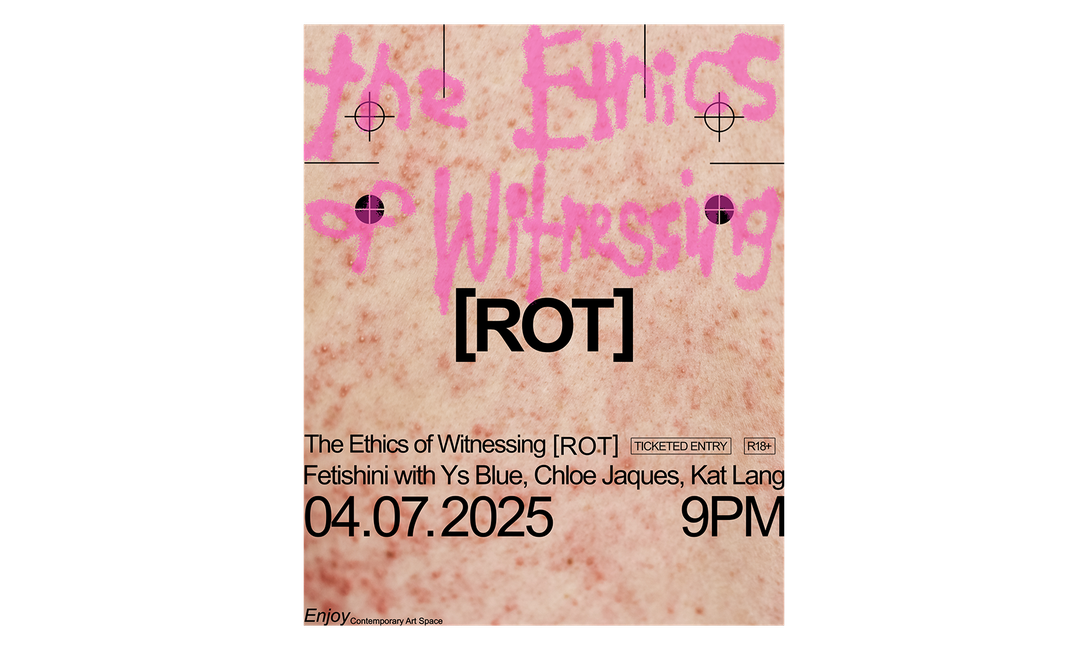past event
The Ethics of Witnessing [ROT]
Friday 4 Jul 2025
9:00pm

Graphic designed by Joe Locke.
Enjoy presents The Ethics of Witnessing [ROT] a one night only performance by Fetishini with Ys Blue, Chloe Jaques and Kat Lang.
“[We] all live with this particular vulnerability, a vulnerability, a vulnerability to the other that is part of bodily life, a vulnerability to a sudden address from elsewhere we cannot preempt.” [1]
The Ethics of Witnessing [ROT] scrutinises the decaying ecosystem of the human body through a spatial anatomy that pulses, bleeds and breaks down. Channelling the aesthetics of horror and drawing on the grotesqueness of bodily transformation and visceral performance, The Ethics of Witnessing [ROT] addresses ecological collapse using the metaphor of anatomical demise. Each performer embodies a disintegrating bodily system: blood, liver and skin. But here they are rendered toxic and excessive, corrupted by the same forces that poison the earth. The internal becomes external, the body becomes landscape, with each organ acting as a site of failure. The Ethics of Witnessing [ROT] proposes the ugliness of collapse as sacred, and evokes a ritual mourning of planetary degradation where the body is rotting with it.
[1] Butler, Judith. 2004. Precarious Life: The Powers of Mourning and Violence. London: Verso.
In Ys Blue’s performance, the dynamics between performer and audience play out as a charged negotiation of power, rooted in the tension between control and submission, visibility and resistance. The performer occupies a deliberately unstable position: objectified yet assertive, seducing the gaze while simultaneously deflecting it. Blue is both hyper-visible and obscured, drawing attention only to destabilise it. The audience’s impulse to witness, to interpret, implicates them in a choreography of desire and authority, but Blue undermines this through strategies of vulnerability, absurdity, and repetition, gestures that recall the figure of the fool. The fool, long cast as marginal or powerless, holds subversive potential, moving laterally through hierarchies and exposing the structures that uphold them. In this space, Blue’s body becomes a volatile site of performance—not just a spectacle but a confrontation—where power is constantly refigured through play, failure, and embodied risk.
In Fetishini’s performance, the skin is a site of tension, a membrane straining to contain the body’s interior. Restrained within the body, the skin becomes a threshold, stretched and pressured by what it cannot fully hold: emotion, trauma, fluid, breath. This tautness mirrors the charged relationship between performer and audience, where containment and exposure are in constant negotiation. The skin, as organ, as sensor, as barrier, becomes animated like an unwilling costume that both conceals and betrays the self beneath. In this, the performance echoes drag’s manipulation of surface and illusion, but pushes it into a space of discomfort and corporeal instability. Rather than transforming the body into fantasy, Fetishini allows the body to remain visibly in crisis, highlighting the fragility of constructed identity and the labour of containment. The internal is made felt through the tension of almost-breaking, a queering of skin itself, as both armour and exposure.
Chloe Jaques’ performance as both actress and performer unfolds as a comedy of struggle. The audience witnesses an unsettling theatre where the grotesque meets the absurd. Bound in plastic tubing, contorted and leaking, the body becomes a stage in itself, a vessel of artifice, a site of violence, a character barely holding together. The comedic elements such as exaggerated gestures, futile attempts at control, slapstick failure, echo the tradition of drag, where excess, illusion, and self-aware performance rupture the binary between real and performed identity. Yet here, drag is stripped of glamour and pushed into the realm of body horror, where theatricality meets abjection. The bleeding body resists resolution, looping endlessly through scenes of restraint and rupture. Jaques’ stage is a place of ongoing disintegration, where the boundaries of role, gender, and genre collapse under pressure. In this way, the performance becomes a parodic tragedy of embodiment, an image of the self as both spectacle and mess.
Cups marks the debut of Kat Lang’s sonic alias, Oedious, a symbolic and sonic investigation, imagined as a small boy trapped in the stomach of a mechanical mother.
Through the medium of noise, Oedious dismantles the rational construction of the legible body. Sound functions not as ornament or accompaniment, but as an invasive force, rupturing the boundaries of comprehension and violently frustrating immediate cognition. Noise here is a material of intensity, a method of disassembling coherence, used to unravel systems that tether the body to fixed narratives and stable identities.
Oedious resists structure, readability, and comfort. The performer’s body becomes a site of collapse, traumatised through systematic neglect and a persistent refusal of warmth — yet compelled into hyper-presence. Form, gesture, and narrative dissolve into a sonic field that drags the performer and the audience into a shared affective extremity. This is saturation: the bowels drop, the ears rupture, the self contorts.
This performance pulls the body to its highest point of tension like a knot in the back, slowly and painfully released by a loving partner. In this release, the self becomes inward, outward, obliterated. The performance becomes a medium of transition. A place where dissolution is not destruction but metamorphosis.
This event is FREE but TICKETED.
There will be NO admittance under the age of 18, or without a ticket.
REGISTER AND GET YOUR FREE TICKET HERE:
https://events.humanitix.com/the-ethics-of-witnessing-rot
CONTENT GUIDANCE
The Ethics of Witnessing [ROT] is a performance artwork that contains nudity, bodily fluids, body horror, sexual references and themes some may find disturbing.
NO PHOTOGRAPHY
Phone cameras will be stickered upon entry.
Upon arriving to the gallery, our host and security will brief you with our Code of Conduct for the evening (also below). Failure to comply with our Code of Conduct will see your prompt removal from the gallery.
OUR COMMITMENT
Enjoy is an artist-led gallery that supports experimental, critical, and risk-taking practices. We are committed to providing a space where artists, audiences, and communities are treated with respect and care.
Some of our performances and exhibitions may involve nudity, bodily fluids, personal or political subject matter, or intense emotional content. We welcome discomfort, but not harm. This Code of Conduct exists to ensure everyone involved is informed, safe, and empowered:
Respect and Consent
- Do not touch performers or artworks unless invited to.
- Do not photograph or film the performance unless explicitly permitted.
- Respect personal space—your own and others’.
- Participation (if invited) is always optional.
Triggering or Sensitive Content
- Content warnings will be clearly displayed.
- If at any point you feel overwhelmed, you may leave and return discreetly.
- You may speak to staff for support, information, or debriefing.
Accessibility
- If you have specific access needs, please inform staff—we are here to support you.
- We aim to provide seating, quiet space, and access alternatives where possible.
ABOUT THE ARTISTS
FETISHINI is a queer, non-binary performance artist whose work navigates the borders of abjection, desire, and identity. Rooted in lived experiences of dysphoria, neurodivergence, and queer embodiment, their practice explores how we define ourselves by rejecting what is considered dirty, shameful, taboo, or threatening to bodily and psychic coherence.
Beginning their creative journey as a drag artist, Fetishini’s work has evolved into performance that entangles body horror, fetish, and emotional intensity. Navigating the slippery terrain where desire and revulsion coexist, Fetishini confronts sanitised cultural narratives about bodily coherence and identity.
Their performances are ritualistic encounters with what we are meant to disown—staging intimacy with shame, fetish, body horror, and emotional excess. In doing so, they offer a kind of exposure therapy through art: not to cure, but to coexist with what we are told to hide.
YS BLUE is an artist based in Tāmaki Makaurau, practicing within the realms of object making, poetry, performance, and the expanded field of craft. Their practice is driven by a material obsession that aspires to undress taboos, interrogate subsumation, and resist commodification. Often working between the liturgical and the pornographic, Blue undoes the binds of function, discipline, and exchange. Blue completed a diploma in Art and Craft (Ceramics) from Hungry Creek Art and Craft School in 2017 and a Bachelor of Visual Arts (Sculpture) from AUT in 2020.
CHLOE JAQUES is a Pōneke based artist whose practice explores the impact and power of the physical self. She is an actor, dancer and performer that creates abstract and thoughtful work in a low maintenance, high energy style.
Chloe has worked under Dame Gaylene Preston for the New Zealand Film Commision, developed her sold out solo show EAT ME for the Tahi Festival: NZ Festival of Solo Performance, premiered the contemporary dance show MANUFACT at the 2022 Fringe Festival and developed The Bed We Sleep Upon as apart of Playstation Gallery’s monthly performance programme. Chloe has also been a regional & national assessor for Shakespeare Globe Centre New Zealand’s University of Otago Sheilah Winn Shakespeare Festival. She is an acting graduate of Toi Whakaari: NZ Drama School and has most recently concluded an artist residency with Barbarian Productions and The Performance Arcade 2024.
KAT LANG’s practice indulges a socially relational realm, using the memetic recontextualisation of physical and cultural material to talk through social space. Lang has focused their engagement in gallery context on privileging immersive and auto-destructive art and interrogating the implied and present bodies of audience, artist(s) and institution. Lang constructs with an intent to pull at the threads of failure, meaning/meaninglessness, the sensory and its emotional appendages.
